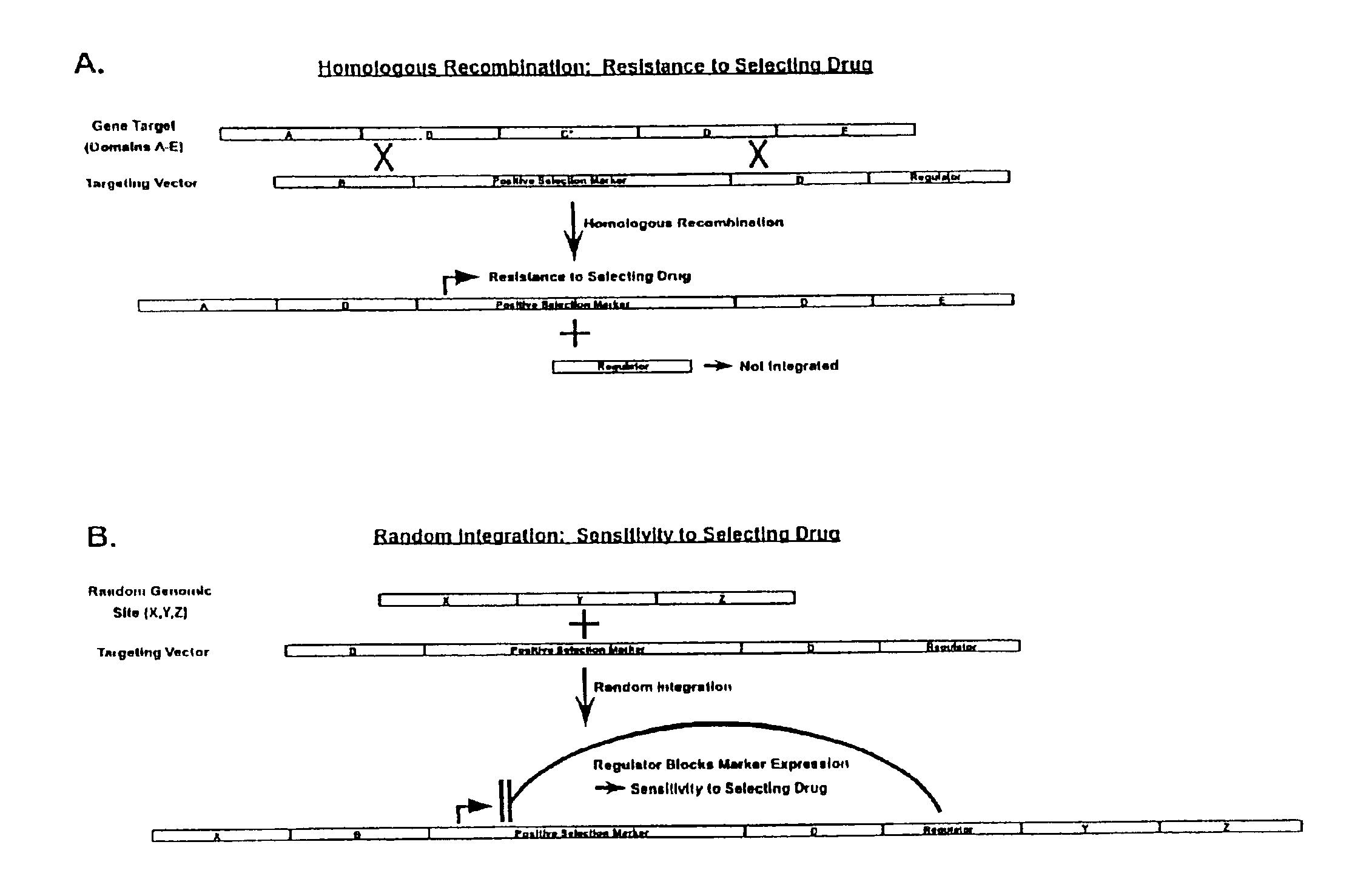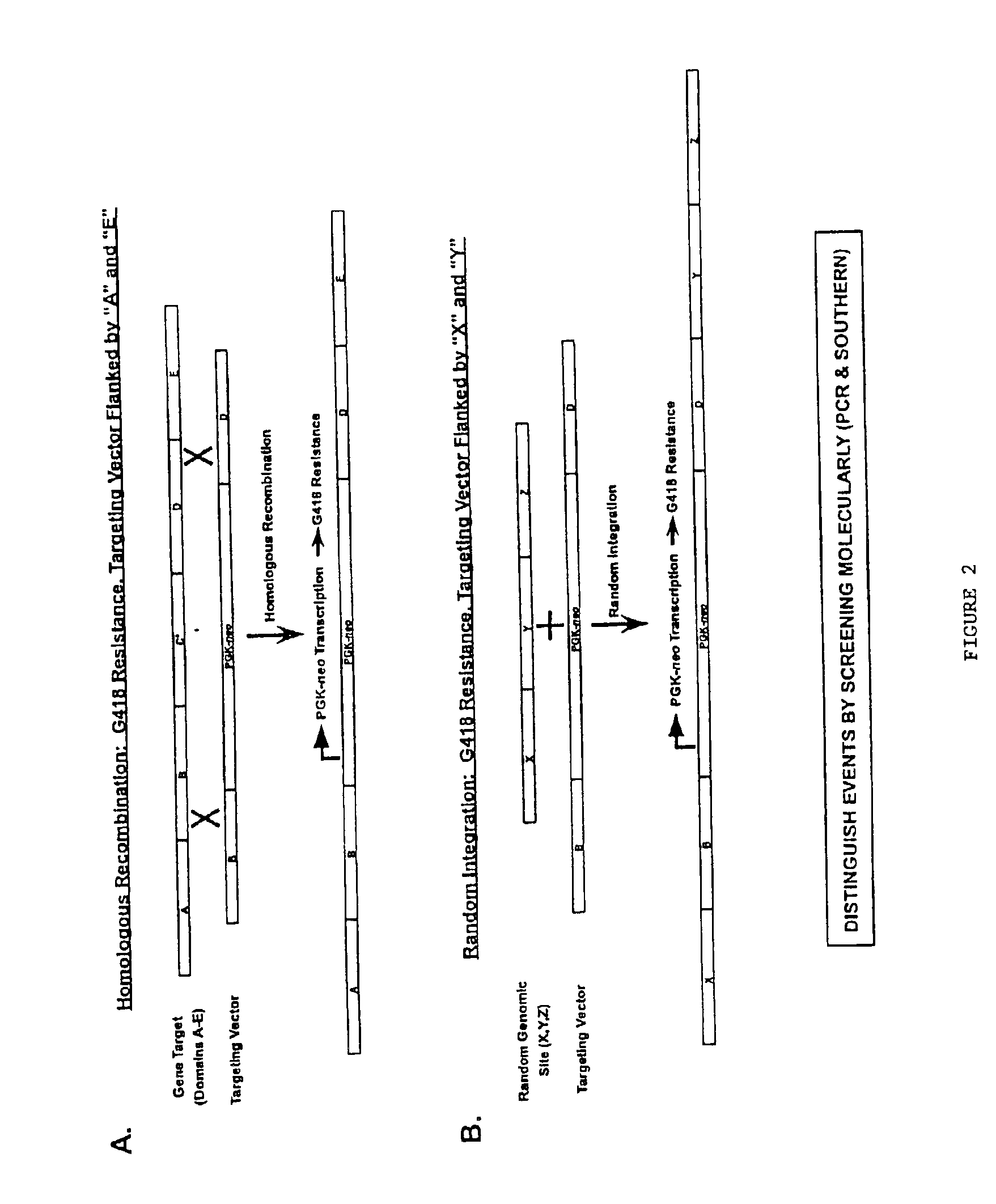Gene targeting vectors comprising conditional positive selection markers
a technology of positive selection and gene targeting, applied in the field of cells and animals, can solve the problems of inefficient recombined, toxic to cells, negatively affecting the ability of cells to populate germlines, etc., and achieve the effects of negatively affecting the ability of es cells to populate mice, and enhancing the recovery of desired mutant cell lines
- Summary
- Abstract
- Description
- Claims
- Application Information
AI Technical Summary
Benefits of technology
Problems solved by technology
Method used
Image
Examples
example 1
Targeting Vector Construction
[0097]Generation of the PGK-lacO-neo Gene. The PGK-lacO-neo hybrid gene was generated in the following manner: Using pDG2 (see U.S. patent application Ser. No.: 08 / 971,310, filed Nov. 17, 1997) as a template, oligonucleotides 10218 and 9959 (FIG. 8) were used in the polymerase chain reaction (PCR) using Expand polymerase (Roche Biochemicals) to generate a DNA fragment containing the second lacO site (FIG. 6). This fragment was digested with Hind III and NcoI (all restriction enzymes from New England Biolabs, Beverly, Mass.). In parallel, the same reaction conditions—except using oligonucleotides 10219 and 4201—were used to generate another DNA fragment containing the first lacO site (FIG. 6). This fragment was digested with Hind III and Eco RI. The two PCR fragments were then ligated together into the Nco I and Eco RI sites of pDG2, replacing the wild-type sequence between these restriction sites. This plasmid was designated as construct 3363.
[0098]Gener...
example 2
Repression of PGK-lacO-neo Expression in Mouse ES Cells
[0100]Four test vectors identified as c3400, c3398, c3396, and c3394 were created to test repression of the selectable marker. Each vector was identical to the other except for the presence or absence of the lacO or lacI sequences (FIG. 9). The lacI sequences were ligated together with the selectable marker sequences using the Bam HI and Sal I restriction sites present in each parent vector, using the plasmid backbone from the selectable marker plasmid. The wild-type PGK-neo fragment was derived from pDG-2; PGK-lacO-neo from c3363; lacI in the coding orientation from c3359; and lacI in the non-coding orientation from c3361.
[0101]To determine whether NLS-lacI could repress expression of PGK-lacO-neo and thus decrease the number of random integration events recovered, the four constructs outlined in FIG. 9 were introduced into ES cells. The effects on neo expression were assessed by counting G418-resistant colonies. Importantly, t...
example 3
Enhancement of Recovery of Homologous Recombination Events
[0104]To determine whether the lac repressor system could be used to enhance the rate of recovery of homologous recombination events, three different types of targeting vectors were constructed (FIG. 11) and used to direct homologous recombination to six different target genes. These genes belonged to different gene families: serine protease, metalloprotease, serine / threonine kinase, serine protease inhibitor, G-protein-coupled receptor, and acylphosphatase.
[0105]The results outlined in FIG. 12 clearly demonstrate that a repressor system can be used to enhance the rate at which homologous recombinants are recovered. Comparing the rates that were observed using no flanking gene (“none”) to those obtained using lacI forward or reverse (“lacI forw +rev”) reveals a higher rate for “lacI forw +rev” in five of the targets. The enhancement varied from approximately two- to six-fold, and in one case (T667), no homologous recombinants...
PUM
| Property | Measurement | Unit |
|---|---|---|
| concentration | aaaaa | aaaaa |
| concentrations | aaaaa | aaaaa |
| concentrations | aaaaa | aaaaa |
Abstract
Description
Claims
Application Information
 Login to View More
Login to View More - R&D
- Intellectual Property
- Life Sciences
- Materials
- Tech Scout
- Unparalleled Data Quality
- Higher Quality Content
- 60% Fewer Hallucinations
Browse by: Latest US Patents, China's latest patents, Technical Efficacy Thesaurus, Application Domain, Technology Topic, Popular Technical Reports.
© 2025 PatSnap. All rights reserved.Legal|Privacy policy|Modern Slavery Act Transparency Statement|Sitemap|About US| Contact US: help@patsnap.com



